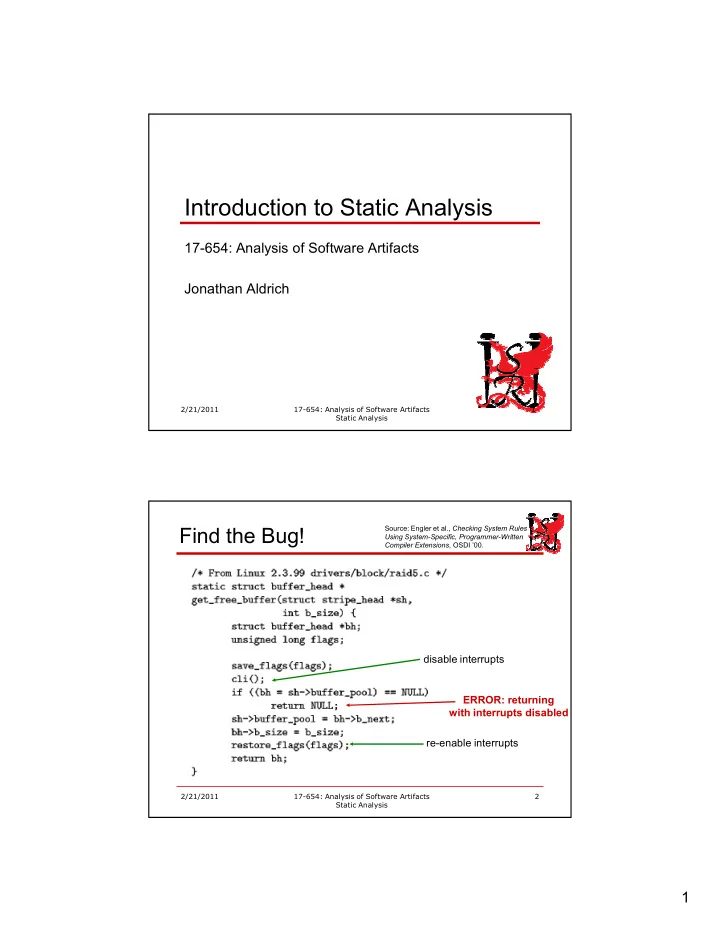

Introduction to Static Analysis 17�654: Analysis of Software Artifacts Jonathan Aldrich ��������� �������������������������������������������������������� � ���������������� Find the Bug! Source: Engler et al., ���������������������� ������������������������������������������ ������������������� , OSDI ’00. disable interrupts ���������������� ������������������������ re�enable interrupts ��������� �������������������������������������������������������� � ���������������� 1
Metal Interrupt Analysis Source: Engler et al., ���������������������� ������������������������������������������ ������������������� , OSDI ’00. enable => err(double enable) is_enabled enable disable is_disabled end path => err(end path with/intr disabled) disable => err(double disable) ��������� �������������������������������������������������������� � ���������������� Applying the Analysis Source: Engler et al., ���������������������� ������������������������������������������ ������������������� , OSDI ’00. initial state is_enabled transition to is_disabled final state is_disabled: ERROR! transition to is_enabled final state is_enabled is OK ��������� �������������������������������������������������������� � ���������������� 2
Outline • Why static analysis? • The limits of testing and inspection • What is static analysis? • How does static analysis work? • AST Analysis • Dataflow Analysis ��������� �������������������������������������������������������� � ���������������� ��������� �������������������������������������������������������� � ���������������� 3
Process, Cost, and Quality Slide: William Scherlis ���������"���#�"���"�� �$$����"������("������ �����"����"$��"�%�����"� �"$�����������"��$�$���� ����$������&��$��� �������(����%� ���������'������ �!%��#�!�"� ���������" *�"�����"�)��+ ��������������!�� ����%��)����� �������� ������� ������� ����������� ���� ������������������������������������������������ ��������������������� ������������������� � � ����!������������ ��������� �������������������������������������������������������� � ���������������� Root Causes of Errors • Requirements problems • Don’t fit user needs ����������������������������� • Design flaws Hard Does design achieve goals? • Lacks required qualities Is design implemented right? • Implementation errors • Assign Is data initialized? � • Checking Security Is dereference/indexing valid? • Algorithm • Timing Are threads synchronized? Hard • Interface Are interface semantics followed? • Relationship Are invariants maintained? Taxonomy: [Chillarege et al., Orthogonal Defect Classification] ��������� �������������������������������������������������������� � ���������������� 4
Existing Approaches • Testing: �������������� • Limitations ������ • Non�local interactions • Uncommon paths • Verifies features work • Non�determinism • Finds algorithmic problems • Static analysis: �����!����� ���������� • Inspection: ������� ������� • Verifies non�local ������ consistency • Missing requirements • Checks all paths • Design problems • Considers all non� • Style issues deterministic choices • Application logic ��������� �������������������������������������������������������� � ���������������� Static Analysis Finds “Mechanical” Errors • Defects that result from inconsistently following simple, mechanical design rules • Security vulnerabilities • Buffer overruns, unvalidated inputK • Memory errors • Null dereference, uninitialized dataK • Resource leaks • Memory, OS resourcesK • Violations of API or framework rules • e.g. Windows device drivers; real time libraries; GUI frameworks • Exceptions • Arithmetic/library/user�defined • Encapsulation violations • Accessing internal data, calling private functionsK • Race conditions • Two threads access the same data without synchronization ��������� �������������������������������������������������������� �� ���������������� 5
Empirical Results on Static Analysis • Nortel study [Zheng et al. 2006] • 3 C/C++ projects • 3 million LOC total • Early generation static analysis tools • Conclusions • Cost per fault of static analysis 61�72% compared to inspections • Effectively finds assignment, checking faults • Can be used to find potential security vulnerabilities ��������� �������������������������������������������������������� �� ���������������� Empirical Results on Static Analysis • InfoSys study [Chaturvedi 2005] • 5 projects • Average 700 function points each • Compare inspection with and without static analysis • Conclusions • Fewer defects • Higher productivity Adapted from [Chaturvedi 2005] ��������� �������������������������������������������������������� �� ���������������� 6
Quality Assurance at Microsoft (Part 1) • Original process: manual code inspection • Effective when system and team are small • Too many paths to consider as system grew • Early 1990s: add massive system and unit testing • Tests took weeks to run • Diversity of platforms and configurations • Sheer volume of tests • Inefficient detection of common patterns, security holes • Non�local, intermittent, uncommon path bugs • Was treading water in Windows Vista development • Early 2000s: add static analysis • More on this later ��������� �������������������������������������������������������� �� ���������������� Outline • Why static analysis? • What is static analysis? • Abstract state space exploration • How does static analysis work? • What do practical tools look like? • How does it fit into an organization? ��������� �������������������������������������������������������� �� ���������������� 7
Recommend
More recommend